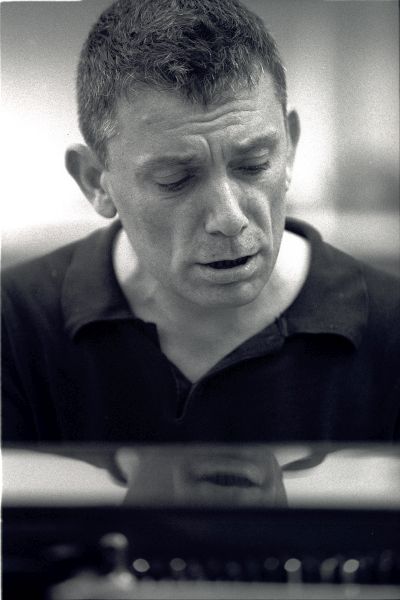 United States Liszt Inspections: Marino Formenti (piano), Stanley H. Kaplan Penthouse, Lincoln Center, New York City, 4.6.14 (DA)
United States Liszt Inspections: Marino Formenti (piano), Stanley H. Kaplan Penthouse, Lincoln Center, New York City, 4.6.14 (DA)

Photo (c) Gyula Fodor
Liszt: Hungarian Folksong in F Minor, S.245/5
Cerha: Knabenschwermut
Liszt: Klavierstück in A Flat Major, S.192/2
Kurtág: …waiting for Susan
Liszt: Bagatelle sans tonalité, S.216a
Ligeti: Étude No.3, “Touches bloquées”
Pesson: Speech of clouds
Rihm: Klavierstück No.6 “Bagatellen”
Klavierstück No.7
Liszt: Michael Mosonyi, S. 205/7
Funérailles, S. 173/7
Ustvolskaya: Piano Sonata No.6
Liszt: Au lac de Wallenstadt, S. 160/2
Berio: Wasserklavier
Adams: China Gates
Liszt: Wiegenlied, S. 198
Feldman: Piano Piece
Liszt: Resignazione, S. 187a
A programme like this, in which Franz Liszt was viewed through some of his decedents and they through him, would have been impossible until recently. It has taken years to rehabilitate Liszt as the radical he truly became, to take seriously his efforts to grapple with what it meant to compose “after” the Wagner of the 1850s and 1860s, a compositional challenge that Liszt himself had done much to support and provoke.
But here we are, with Liszt as progenitor for all manner of styles at least a century after his death. Marino Formenti is not the first pianist to treat Liszt in such a way. In the bicentenary year, for instance, Pierre-Laurent Aimard explored his influences on Wagner, Berg, Scriabin, Bartók, and more. Formenti, though, has gone further, finding parallels with minimalism, with expressionism, with silence, and with the most brutal atonality. These Inspections were like a gallery in sound, linked more aurally than intellectually, with flourishes reimagined here, and hints of certain techniques fully formed or deformed there. They suggested, as Formenti put it, that Rihm is to Liszt as Rothko’s abstract expressionism was to the skies of Turner.
Just as importantly, the Liszt presented here was a much more productive Liszt than we usually hear in the concert hall. Even the most ardent Lisztian would surely accept that his body of work was variable. Probably this is no more true than for other composers, but for some reason the reputation has stuck. So too few are the occasions when we hear more than the Sonata, the Hungarian Rhapsodies, a few of the Études, a couple of the Harmonies poétiques et réligieuses, many of the Années de pèlerinage, a handful of late works (Nuages gris, Unstern! Sinstre, and R.W.–Venezia), and of course the lollipops. One of Formenti’s successes here, among many, was to achieve a reassessment of Liszt born mostly from repertoire rarely recorded and even more rarely performed, the Funérailles and Au lac de Wallenstadt excepted. And in turn yet more allusions were suggested, to Beethoven in some of the pieces, and especially to Debussy. So a question left unanswered through this concert was just who was inspecting whom.
Not everything worked. A few of the links suggested were a bit obtuse. John Adams’s banal China Gates was not well served by following a charming but guileless version of Au lac de Wallenstadt and Luciano Berio’s serene Wasserklavier, a piece that echoes Liszt’s flowing arpeggios in a tonal but offish style. Nor was each individual piece successful. The Bagatelle sans tonalité was first tentative and later slipshod, and Ligeti’s Touches bloquées had none of the rhythmic incision and quirky character that other pianists might revel in.
Still, the emotional arc of the programme as whole was satisfying, building to two of Wolfgang Rihm’s Klavierstücke and fading away in Liszt’s Resignazione, a tiny, bluesy piece that signalled safe arrival in E major with its opening chord, but simply drifted off mid-sentence in its last four bars, its key and direction unclear but leaving no doubt that it was searching for something. Arrival, though, simply meant a return to the rootlessness of the opening Hungarian Folksong, its suspensions and layerings lingered over by Formenti. Liszt throughout felt questioning, whether in the not-quite-there climaxes of the Klavierstuck, the disoriented reach of Michael Mosonyi, or the impossible delicacy of the Wiegenlied.
Few questions were answered by the contemporary works, but that was not the point. The Rihm worked particularly well as a central diptych. A series of linked miniatures, the sixth Klavierstück wanders claustrophobically in tight lyricism, before exploding into riotous thwacks. The seventh drew growls from the piano stool, its aggressive rhythmic haymakers disguising a hopeful promise written in language almost identical to Liszt’s, repeated chords leading to a thumping climax in a rare major.
But the Rihm turned out to be a false peak before the crashing ferocity of Galina Ustvolskaya’s Sixth Sonata, a shocking, pounding work that deploys the pianist’s whole forearms multiple times, even his legs as he stands for extra power. Among the nasty crunches there was yet another link back to Liszt—the Catholic Liszt—as a chorale, written but barely heard among the din, struggled to make itself felt. Of the other works, György Kurtág’s … waiting for Susan entranced with its tenderness, Gérard Pesson’s Speech of clouds seemed a bit close to Debussy for comfort, and Morton Feldman’s Piano Piece played with silence as only that composer could.
Liszt needs more treatment like this, and, conversely, so do contemporary composers. This wasn’t always convincing, but it was engrossing.
David Allen